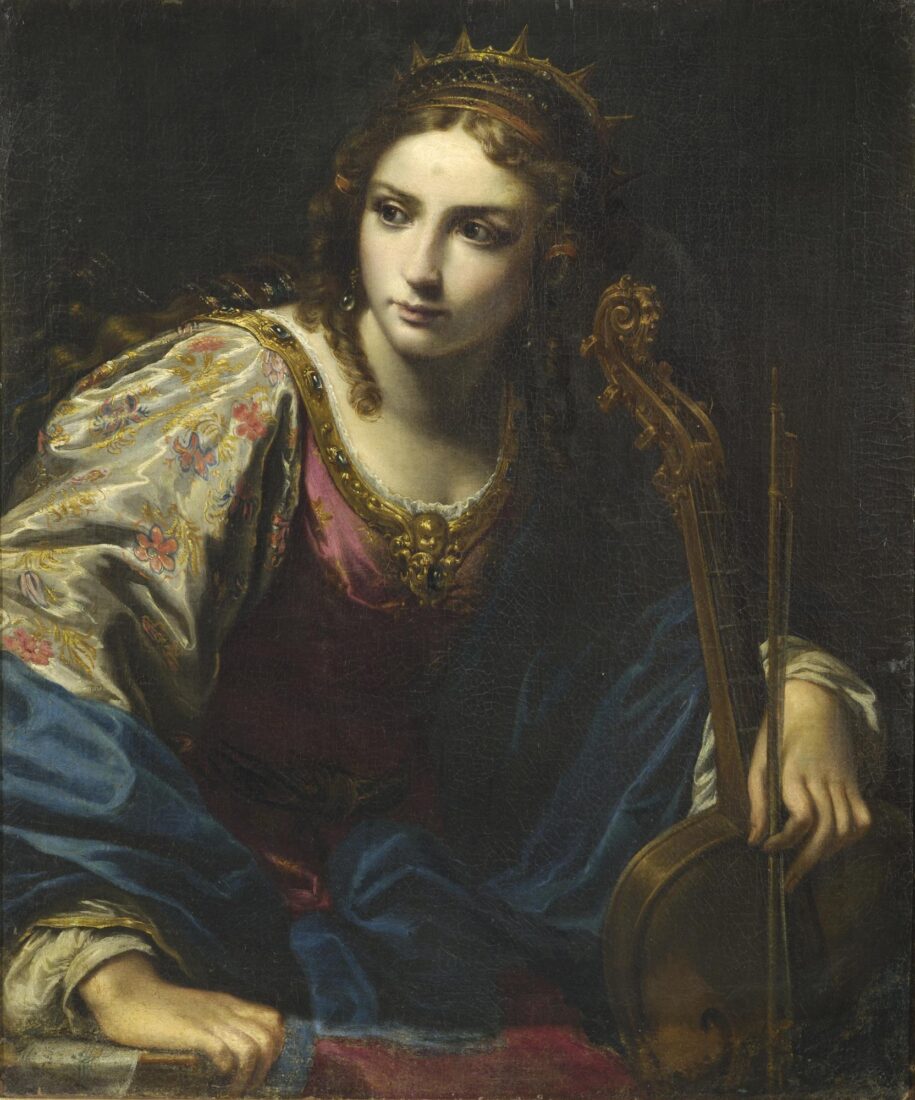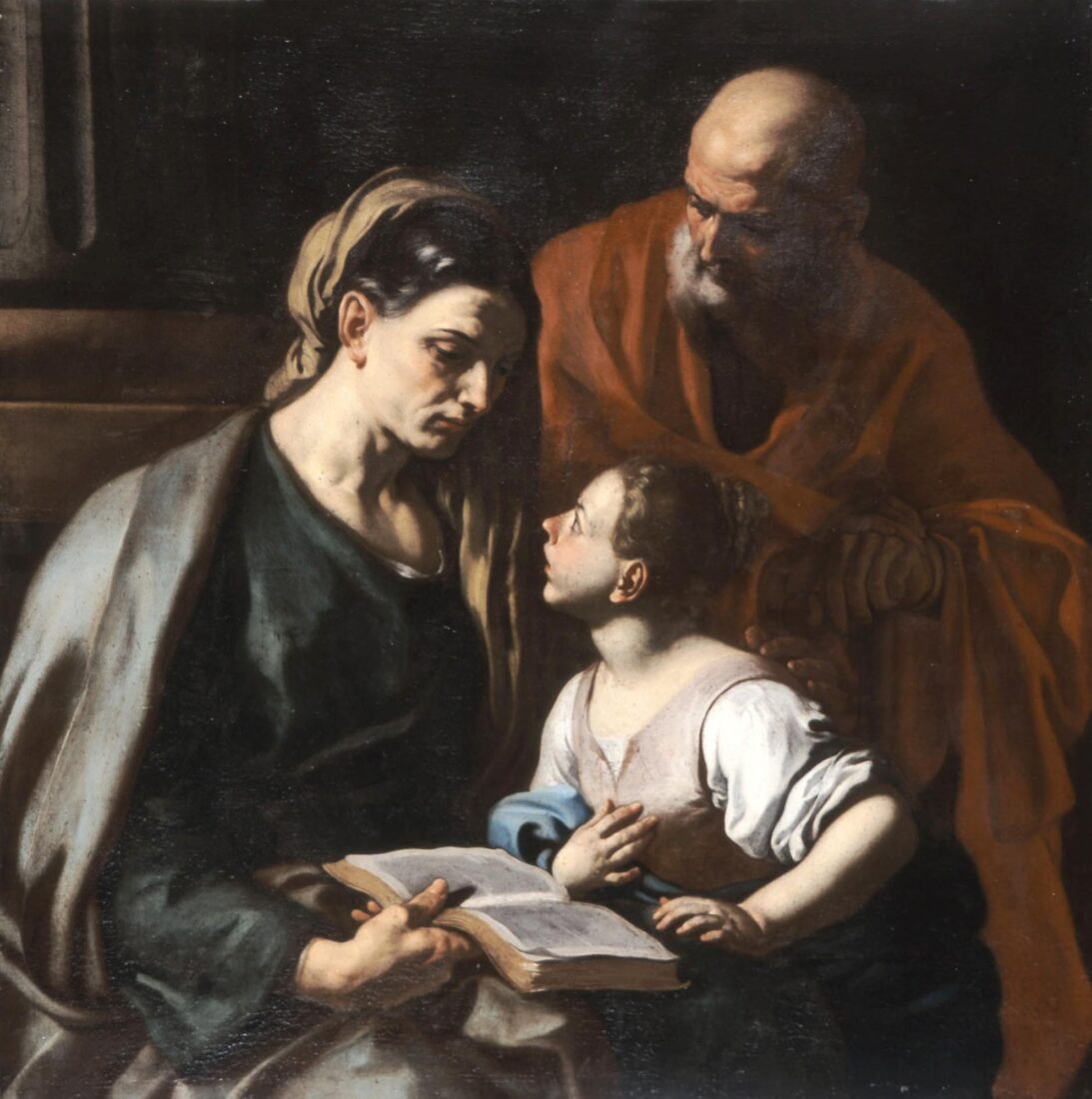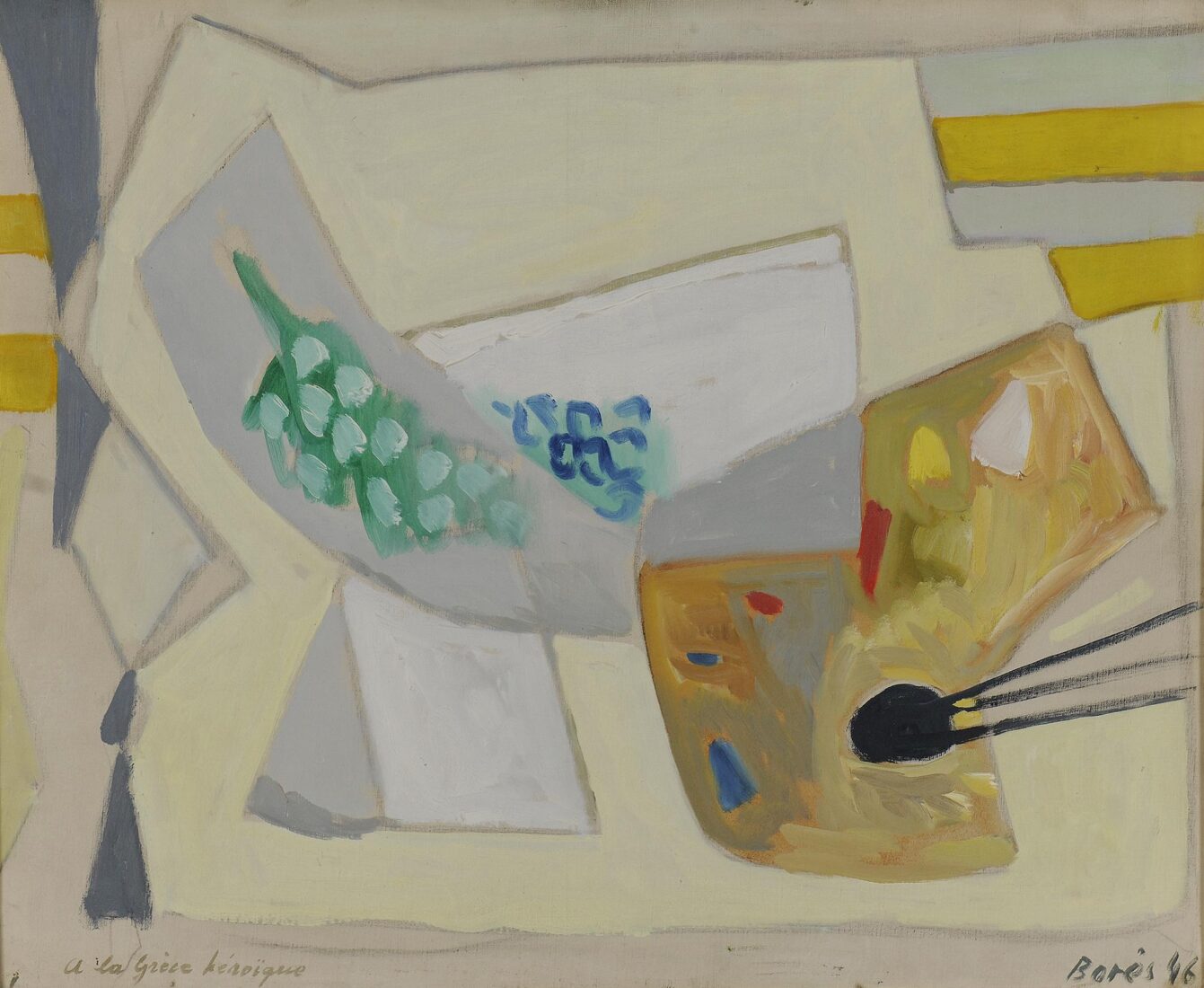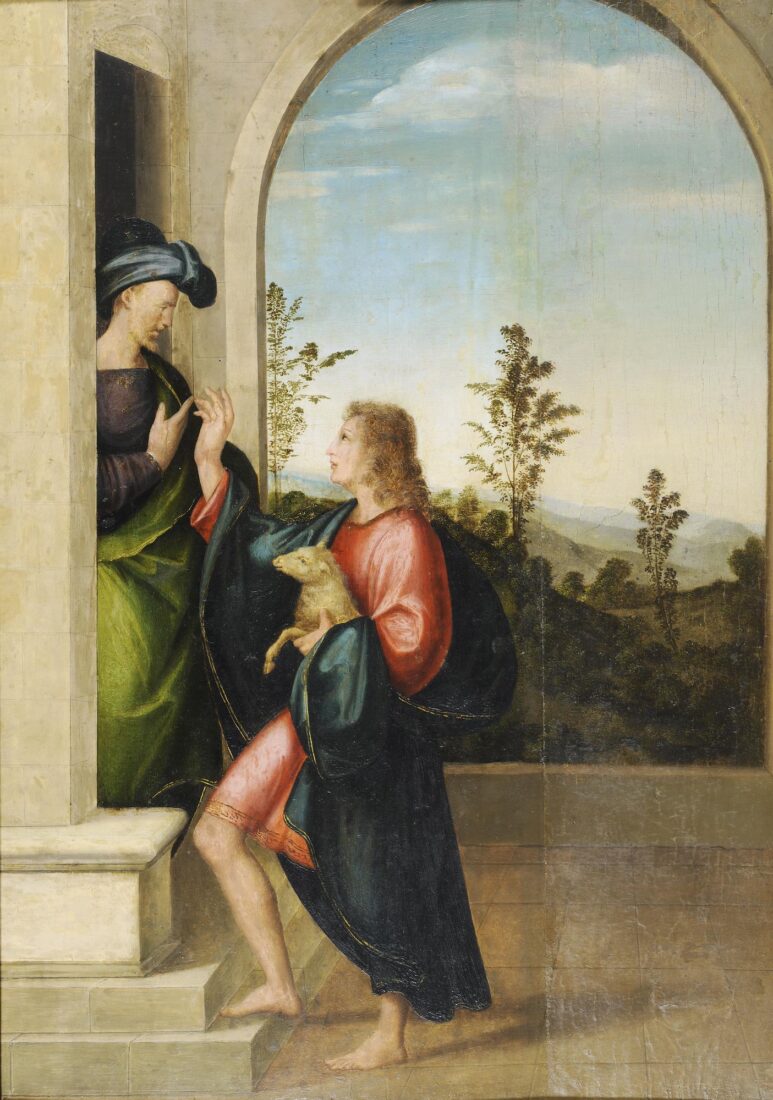

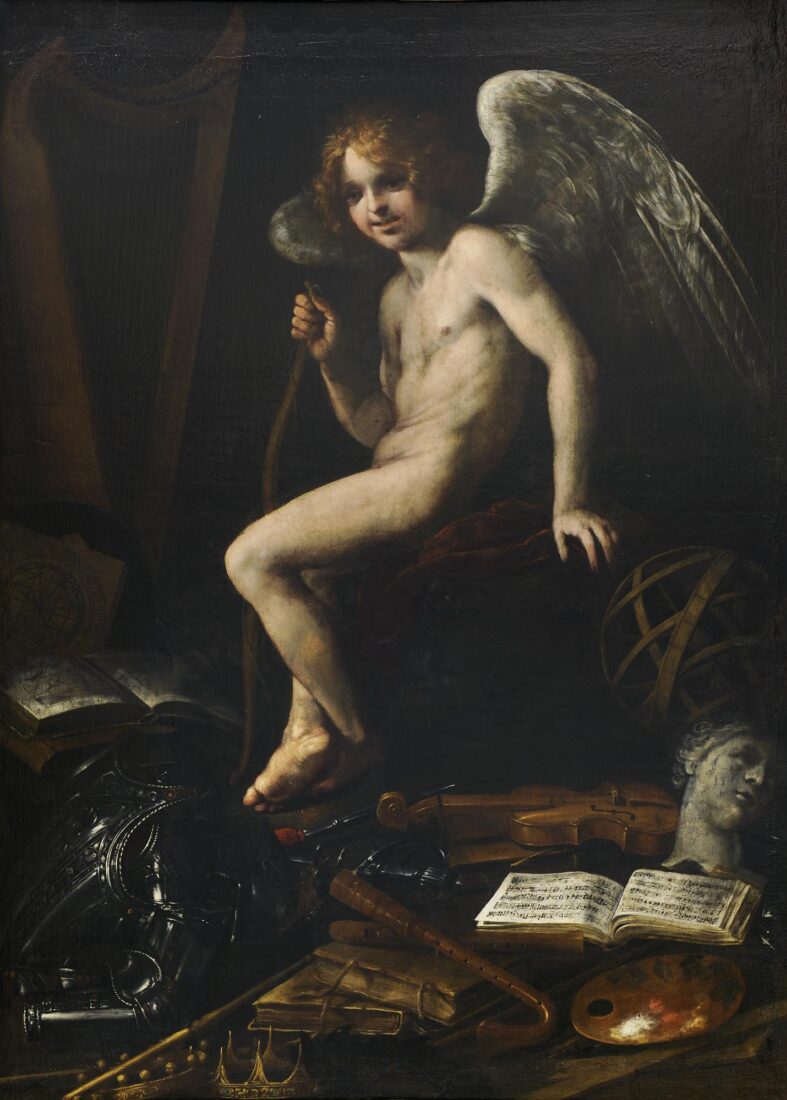
The painting illustrates an excerpt from Virgil’s Idylls (X. 69) which lauds the invincible power of Love (Eros): “Amor vincit omnia et nos cedamus amori”. The painter had recourse to the figure of a winged youth, holding a bow in his hand, the characteristic symbol of Eros (Cupid). The apparent indigence of the young man, who is presented naked and who is turned facing the viewer with his melancholic and, at the same time, sarcastic gaze, is in stark contrast to the wealth of objects that surround him: an enormous harp, the carved suit of armor, the books and musical instruments, the astrolabe, the sculpted head and a painter’s palette; all objects which signify worldly satisfaction and human knowledge which Eros disdains and enslaves with his passion. This type of allegorical presentation, the ambiguity of which is one of its most charming features, was in great demand by aristocrats and the more exalted prelates of the Roman Catholic Church at the beginning of the 17th century. Eros Triumphant, done by Caravaggio for the Marquis Vincenzo Giustiniani in Rome in 1601-1602 (Berlin, Germaldegalerie), not only made an enormous impression of the art lovers of the time but also gave rise to a frenetic competition between the imitators and the adversaries of the Lombard painter Giovanni Baglione who, in 1603, took Caravaggio to court and several of his friends, and who painted for Cardinal Benedetto Guistiniani, brother of Vincenzo, two versions, moralistic in character, of the same subject, Eros Triumphant, incorporating the figures of Celestial and Terrestrial Eros (1602, Berlin, Germaldegalerie and Galerie Nationale di Palazzo Barberini, Rome).
Several years later depictions of Eros triumphant made their way to the forefront again as they were sought after by Tuscan collectors. The composition of the work at the National Gallery has many points in common with the Caravaggian model, the main difference being that the youth is staring straight ahead and the rendering is more restrained. The stylistic perception governing the work is related to that of Florentine painting from 1620-1630.
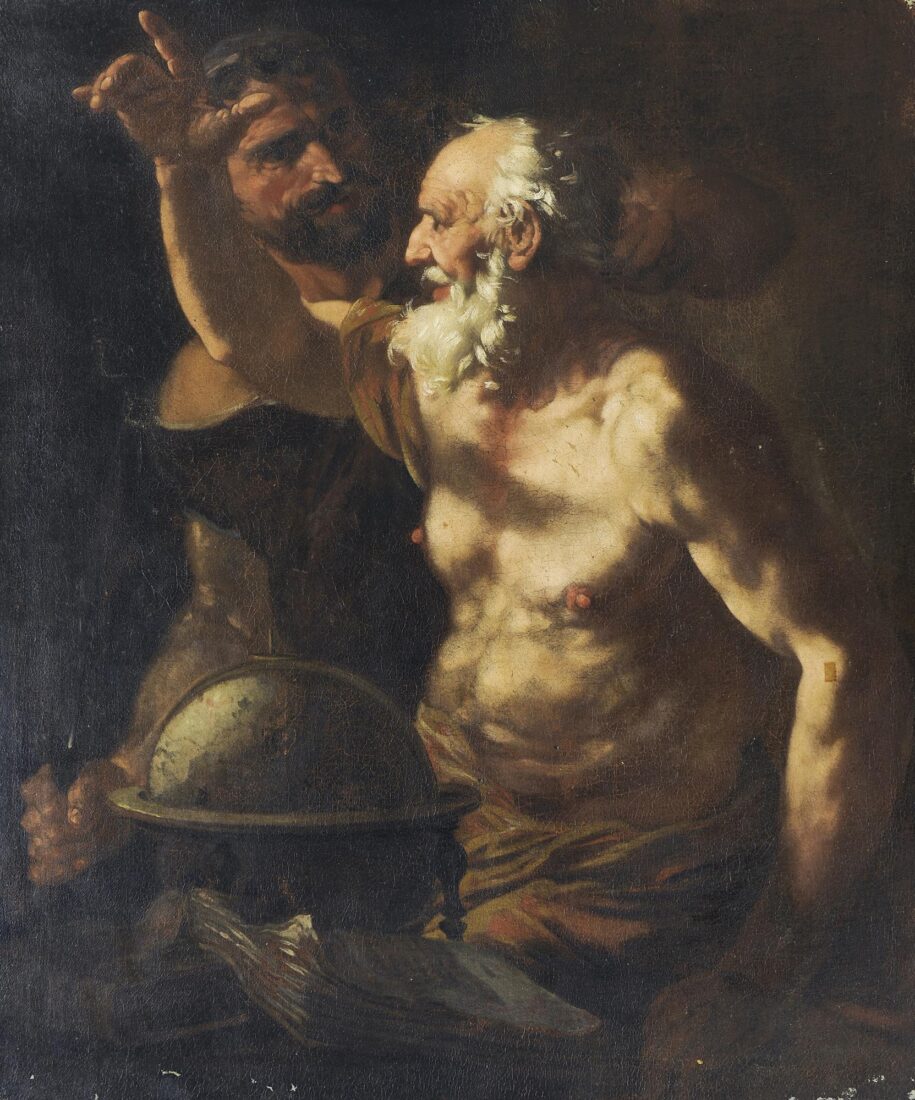
When this work was made part of the collection at the National Gallery, it was at first attributed to Jusepe de Ribera (1591-1652) who settled in Naples where he became acquainted with Caravaggio and fell under his influence. Professor Gerhard Ewald, however, attributed the work, in his book Johann Carl Loth (1632-1698), Amsterdam 1965, to the German painter Johann Carl Loth.
In the work at the National Gallery one sees, in all likelihood, a depiction of Plutarch’s version of how Archimedes died. This occurred during the conquest of the Syracusans by the Roman legions under Marcellus. “As fate would have it he was alone, intent on working out a problem by means of a diagram. And as both his mind and his eyes were absorbed with these speculations, he remained completely unaware of the Roman incursion, not even realizing the city had been taken. Suddenly, he found himself face to face with a soldier who commanded him to follow him to Marcellus. But Archimedes refused to budge until he had solved the problem to his satisfaction and demonstrated it. This infuriated the soldier who drew his sword and ran him through…” (translation of the relevant section on Marcellus of the Greek edition of “Plutarch’s Lives”, edit. Philologiki, vol. II, Athens, n.d., p. 212). In the painting, the soldier, holding his sword in one hand, has lifted it with a violent movement and is holding Archimedes by the throat; he appears quite unfazed, with an absorbed look and making an emphatic gesture which shows his determination to not go with him until he has solved the problem he is involved with.
The composition is faithful to all the elements characteristic of Loth’s works. The soldier and Archimedes create, with their bodies, the sphere and the account books, a compact group that occupies nearly the entire surface of the painting. The soldier, tall and well-built, is in almost complete shadow, standing behind Archimedes’ uplifted arm while the light falling on the primary plane in practically the center of the composition, creates contrasts between the light and dark planes, revealing the elderly body of Archimedes, still strong despite his great age, as well as his strong-willed personality. The dark brown colors in combination with the intense lighting serve to stress the dramatic character of the scene.
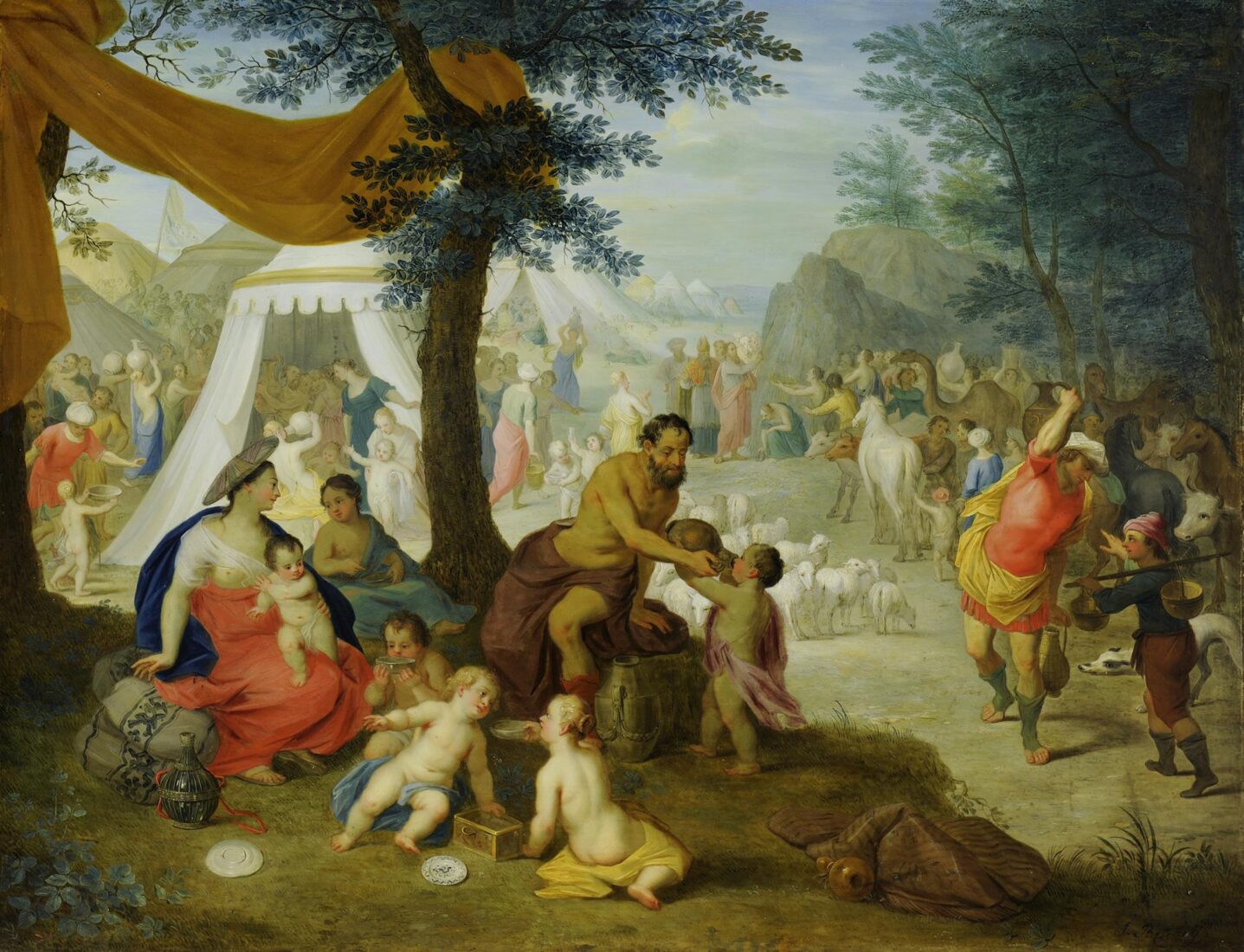
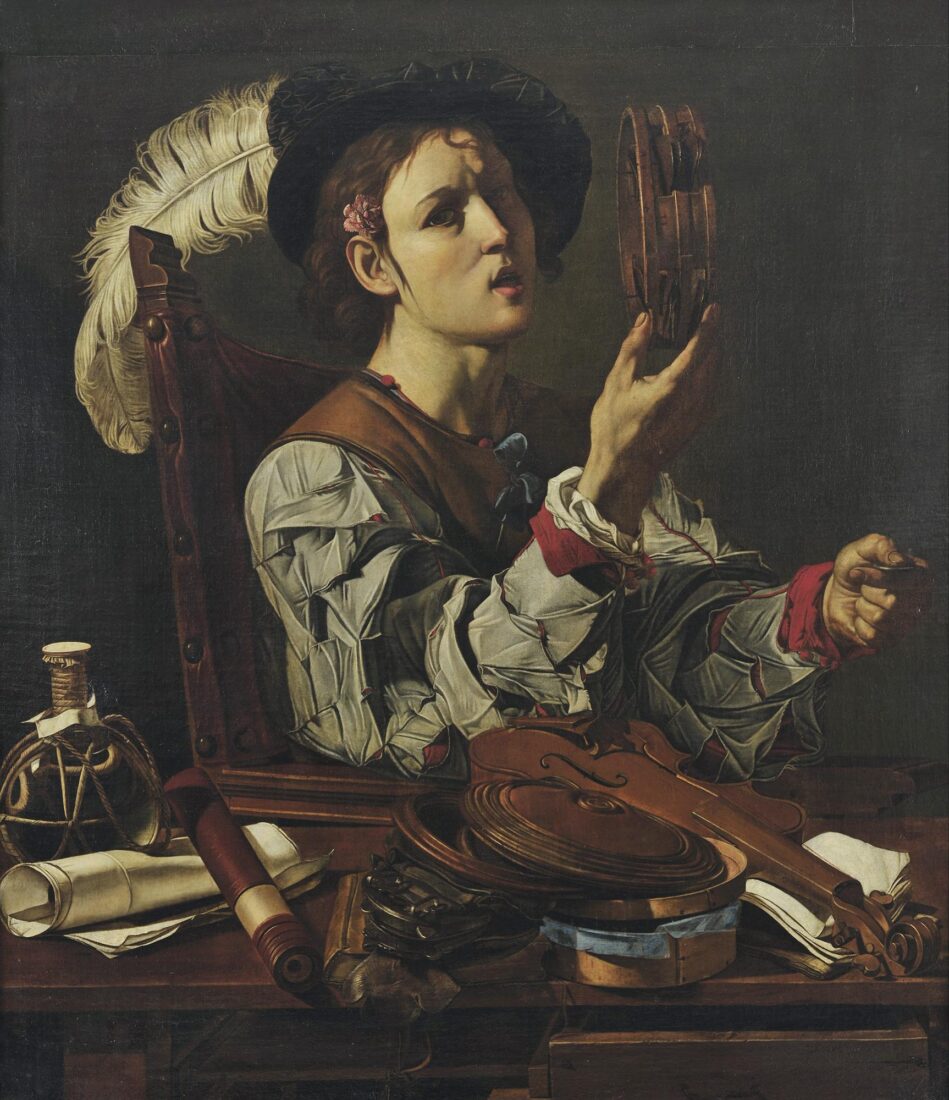
This painting, originally entered in the archives of the National Gallery as a work by Michelangelo Merisi da Caravaggio, was later attributed to Cecco del Caravaggio by Roberto Longhi. The identity of the painter called Cecco del Caravaggio was unknown. He was believed to be alternately French, Spanish, even Dutch, whereas Gianni Papi identified him as the Italian Francesco Boneri (G. Papi, “Cecco del Caravaggio,” Nuova Memoria, Florence, 1992).
Cecco del Caravaggio (Cecco is short for Francesco) worked in Italy during the first half of the 17th century. Mancini, in “Considerazioni sulla Pittura”, c. 1620, refers to a Francesco, called del Caravaggio, as an admirer and imitator of Caravaggio. It seems that the high regard Francesco had for the Lombardian painter, and his ability to imitate the master, gave him the pseudonym del Caravaggio.
This painting has generated much debate over its content. Roberto Longhi chose the title “Musical Instrument Maker” on the basis of the round object that the young man holds in his hand, which he seems about to place on the tambourine. Besides the violin – and it’s unclear whether this has been constructed or simply repaired – there is nothing else to indicate an association with this occupation. Furthermore, the array of objects in the foreground, which, aside from the violin, have nothing to do with music, heightens the mystery surrounding its theme. The painting’s enigmatic and allegorical character allows us to speculate that it was directed towards connoisseurs – a reason why A. Cottino chose the title “Allegorical Portrait of a Youth with Musical Instruments” (A. Cottino, “La natura morta caravaggesca” in “La natura morta in Italia”, vol. II, p. 726).
On the occasion of the publication of the work in the 2018 Calendar, in the introductory text, the director of the Athens National Gallery, Marina Lambraki Plaka, commenting on the painting, proposes the title Young Musician in a Workshop of Musical Instruments or Allegory of the Five Senses”: “The work was originally, and for many decades, known under the title given by the eminent Italian art historian Roberto Longhi: Musical Instrument Maker. Under this title, it was featured in many international exhibitions. The young man’s sumptuous dress, however, the feathered hat, and the carnation behind the ear, his noble features, as well as his placement in the composition, preclude this identification. Craftsmen are commonly seen in contemporary paintings and accounts of the time to wear casual, worn-out clothes, leather aprons, and their rough figure often betrayed their low-class origin.
The young nobleman is seated on a luxurious chair, with a high backrest, behind a bench or table, with open drawers that face the viewer. This was a common artists’ device aimed at making the viewer identify with the invisible interlocutor of the depicted figure. But what is the identity of the figure that does not appear in the painting? A musical instrument dealer? In this case, his young patron is offering him a coin in his left hand as payment for the tambourine in his right. A musical dilettante who was also a musical instrument collector? We may never know. What about the objects scattered on the bench, masterfully painted in illusionistic verisimilitude? A violin, a small telescope, hastily folded document scrolls, empty round boxes, and a wine carafe. Let’s attempt a new interpretation here: Whatever the thematic pretext, this enigmatic scene may be an allegory of the five senses: the musical instruments, the inaudible sound of the tambourine and of the song suggested by the boy’s half-open mouth all evoke the sense of hearing; his left hand, holding the coin, denotes touch – as does the feather that adorns the young man’s hat; the small telescope and the painting as a whole are a celebration of sight; smell is suggested by the carnation – that explains why the fragrant flower was introduced, placed behind the young man’s ear. The wine carafe, finally, is a tribute to the fifth sense, taste. This is how the mystery of the juxtaposition of such disparate objects in this captivating painting can be solved.”
Gianni Papi dated this painting to the mid-1620s. A second version of the picture with some variations mostly in the garments, the facial expression and the position of the musical instrument held by the youth, is in the Wellington Museum in London.
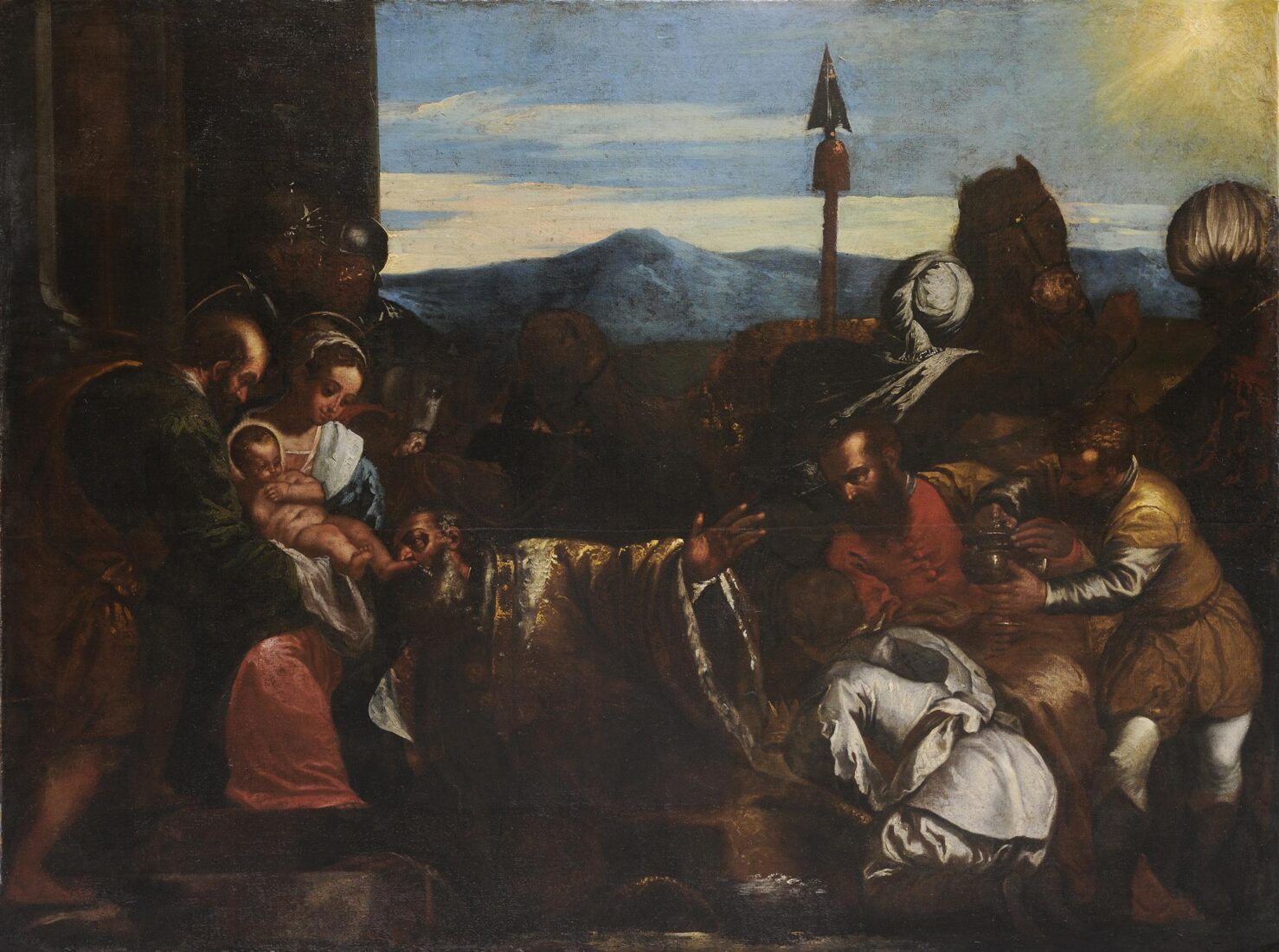
This painting is a variation of a work by Paolo Caliari (better known as Paolo Veronese), which is in the library of the Ateneo Veneto (Istituto Veneto di Scienze, Lettere ed Arti in Venice). The Ateneo Veneto is a non-profit institution that was founded in 1812 and is housed in the building of the Scuola Grande di San Fantin, also known as the Scuola di Santa Maria e di San Girolamo. In 1562 a number of great architects, painters and sculptors, amongst them Veronese, embarked upon a major reconstruction and decoration scheme for the Scuola, which had been destroyed in a fire. This date also defines the period during which this composition was created, that is to say, after 1562 or possibly in 1563, a time when religious painting followed the edicts of the Council of Trent (1545- 1563), which issued condemnations of what was judged as heresy committed by Reformation Protestants. In its final session, in 1563, the Council delineated the rules for religious images: they were to undertake the role of the ‘book for the illiterate’ and had to be comprehensible to the faithful and approved by the bishop.
“The Adoration of the Magi” is an image that is readily understandable. The Holy Family is placed off-centre, on the left side of the composition. The Virgin Mary, with the Christ Child in her arms, is sitting on the steps of a magnificent building and extends Jesus’ tiny foot to the first magus to kiss. Joseph, on the very left, with his side and back to the viewer, is helping and at the same time protecting them. Behind the kneeling magus follows a second, while the third is not completely visible. The protagonists are surrounded by horses and soldiers, while two servants in the foreground hold the gifts.
In comparison to the Ateneo Veneto work, the National Gallery painting is different in several ways, mainly in size. Although the National Gallery work is larger, a substantial part from the right side of the composition is missing, as well as a part from the left. In addition, the many over-paintings prove that it has suffered damage in the past. In the recent attempt to conserve it, the removal of a large part of the over-paintings, mainly from the cape of the magus, revealed a refined, albeit chromatically dull brushstroke. The painting’s quality, however, leads to the conclusion – with all due reservations – that this is a version of the Ateneo Veneto work created if not by someone from the studio of Veronese, then by someone close to his time who followed his example.
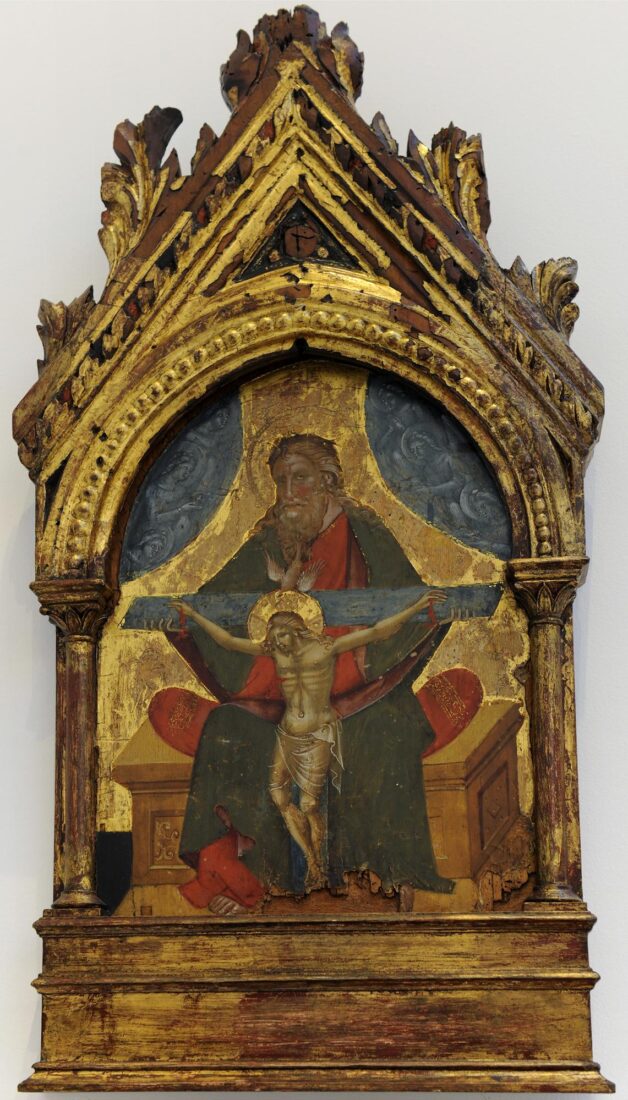
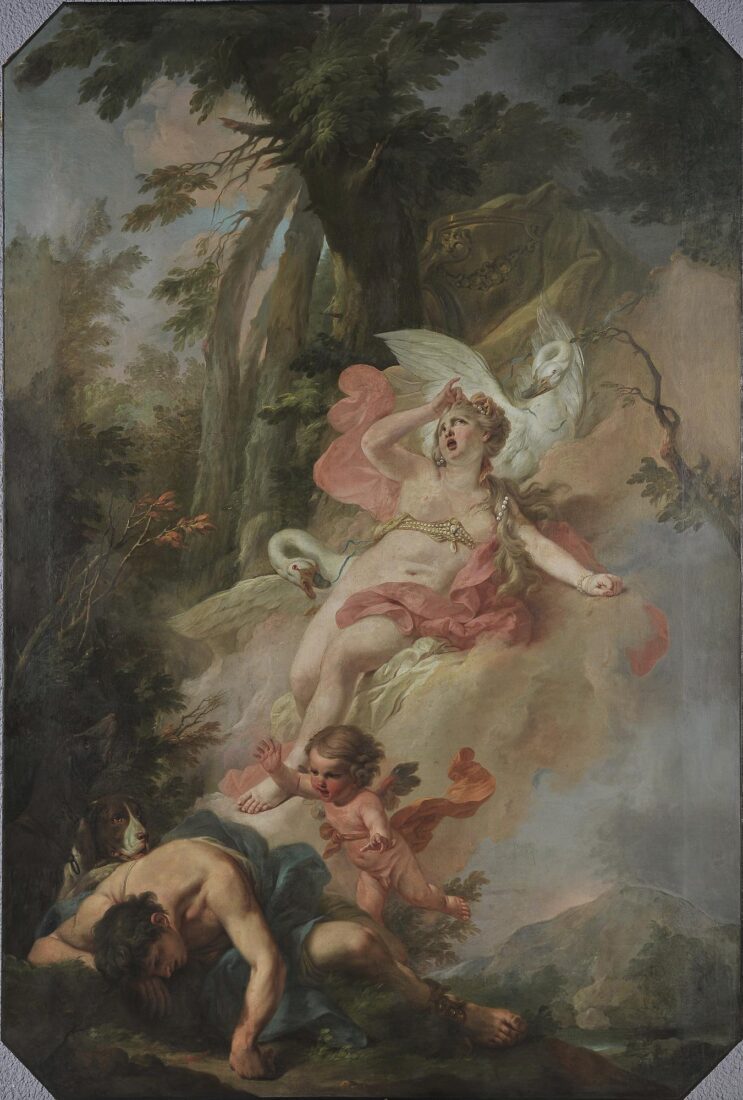
The son of Guillaume-Thomas Taraval, appointed artist to the court of Frederick I of Sweden, Hugues Taraval after his father’s death studied at the workshop of Jean-Baptiste Pierre (ca. 1713 – 1789). A member of the Royal Academy since 1769 and inspector at Gobelins since 1783 was one of the artists who contributed to the large decorative projects carried out during the reign of Luis XVI. His favourite subjects include the love affairs of Aphrodite, such as the one with Adonis.
A youth of incomparable beauty, Adonis, the son of Smyrna, one of Aphrodite’s favourite lovers, was mortally wounded by a boar during a hunt. The work captures the moment when Aphrodite, accompanied by a cupid and two swans, discovers in shock her lover’s dead body lying on the ground, next to his two hounds. The diagonal composition, the spiralling pose of the goddess and the swans, the vestments flying back with the speed of the descent, the pink hues on the flesh and clothing, all add an air of lightness to the event, in spite of the dead body in view and the surprise, anxiety and terror evident in the faces of Aphrodite and the cupid. Even though a forgotten artist today, Taraval is a typical example of 18th-century court painting in France.
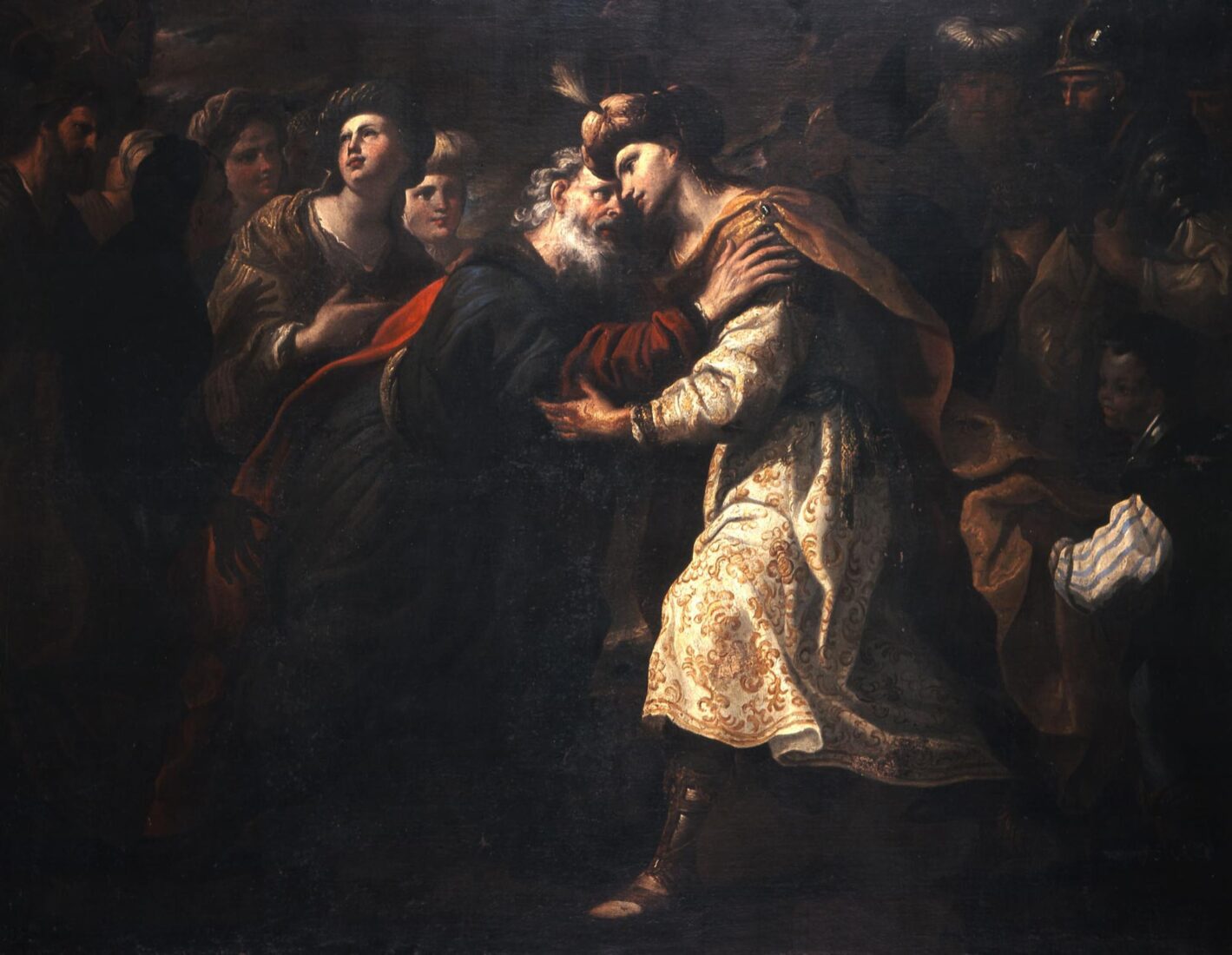
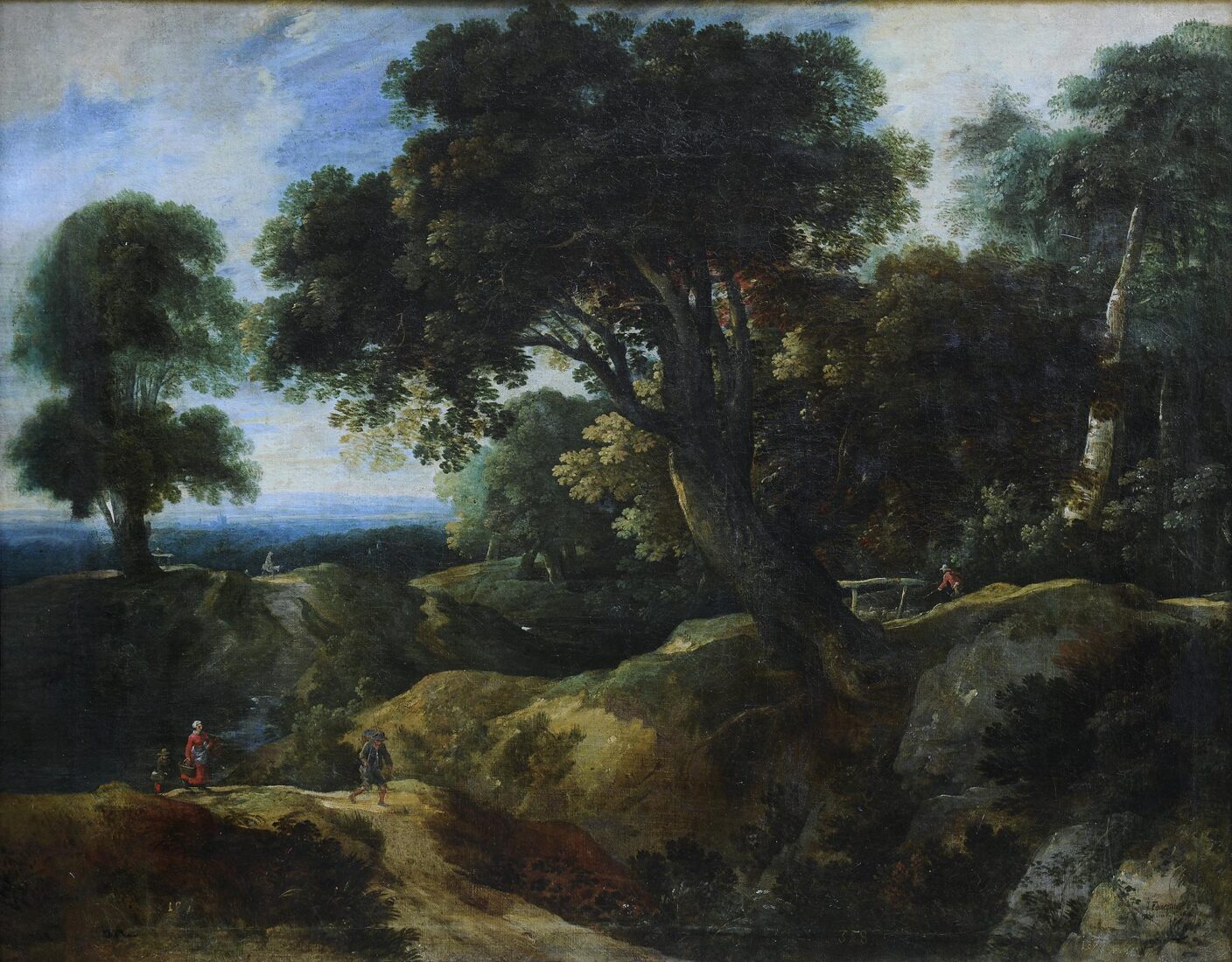
Foucquieres’s work at the National Gallery presents a number of similarities to many of the landscapes by Dutch and Flemish artists in the seventeenth century and is organized in a like manner, that is, these landscapes are bordered to the left and right by trees, or rows of trees, usually interrupted in the middle by rivers or narrow lanes, while the horizon disappears into the remote depths. In the idyllic nature of these works there are scattered figures, usually small in size, of villagers, hunters or shepherds. Landscapes of this type were made, for example, by Lodewijk de Vadder, Jacques d’ Arthois, and Paul Bril. The signed work by Foucquieres at the Fine Arts Museum of Nantes, “Rugged Landscape with Hunters”, from 1620, also appears to have a connection to the work at the National Gallery. The dominance of brown tones in the foreground, green in the middleground and blue in the background, is one of the elements these two works have in common. The organization of the two landscapes also reveals certain other correspondences. Green areas of dense vegetation with tall trees alternate with heights, while in both works the landscape is interrupted in the middle: a river that diagonally traverses the landscape at the Nantes Museum has also been inserted in the landscape at the National Gallery.
The idyllic twilight landscape at the National Gallery, which hosts a shepherd and his flock, is more particularly related, however, to the prolific production of pastoral landscapes in the Low Countries during the 17th century. The production of these pastoral scenes in the Low Countries during that period is in turn connected to a more widespread tradition. Both in the art and in literature of the European Renaissance, from Italy and France to Spain and the Low Countries, and from at least as early as the 16th century, the bucolic genre boasts many examples. The “Idylls” of Theocritus and the “Eclogues” of Virgil are, of course, to be found at the commencement of this tradition, which was also particularly vital among the aristocratic circles of the period who celebrated, read and staged these bucolic scenes in theatres and masques. Rubens, Jacques d’Arthois, Paul Bril, Jan Wildens, and Gillis Neyts are all included among the many Flemish painters of bucolic landscapes. A common characteristic of many of these images was the small scale of the figures of the shepherds and their flocks, that were incorporated into landscapes of lush vegetation, usually wooded, and commonly depicted at sunset.
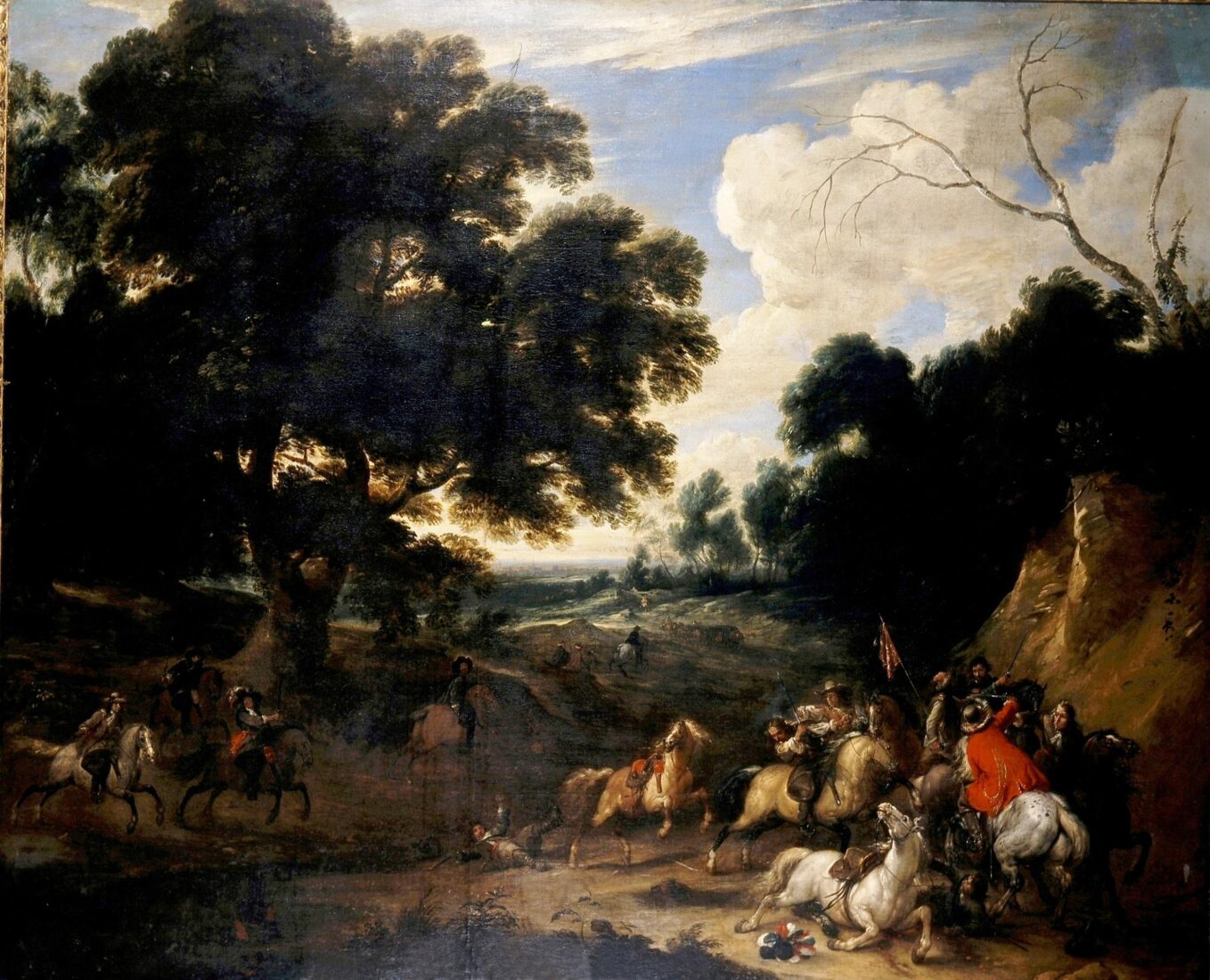
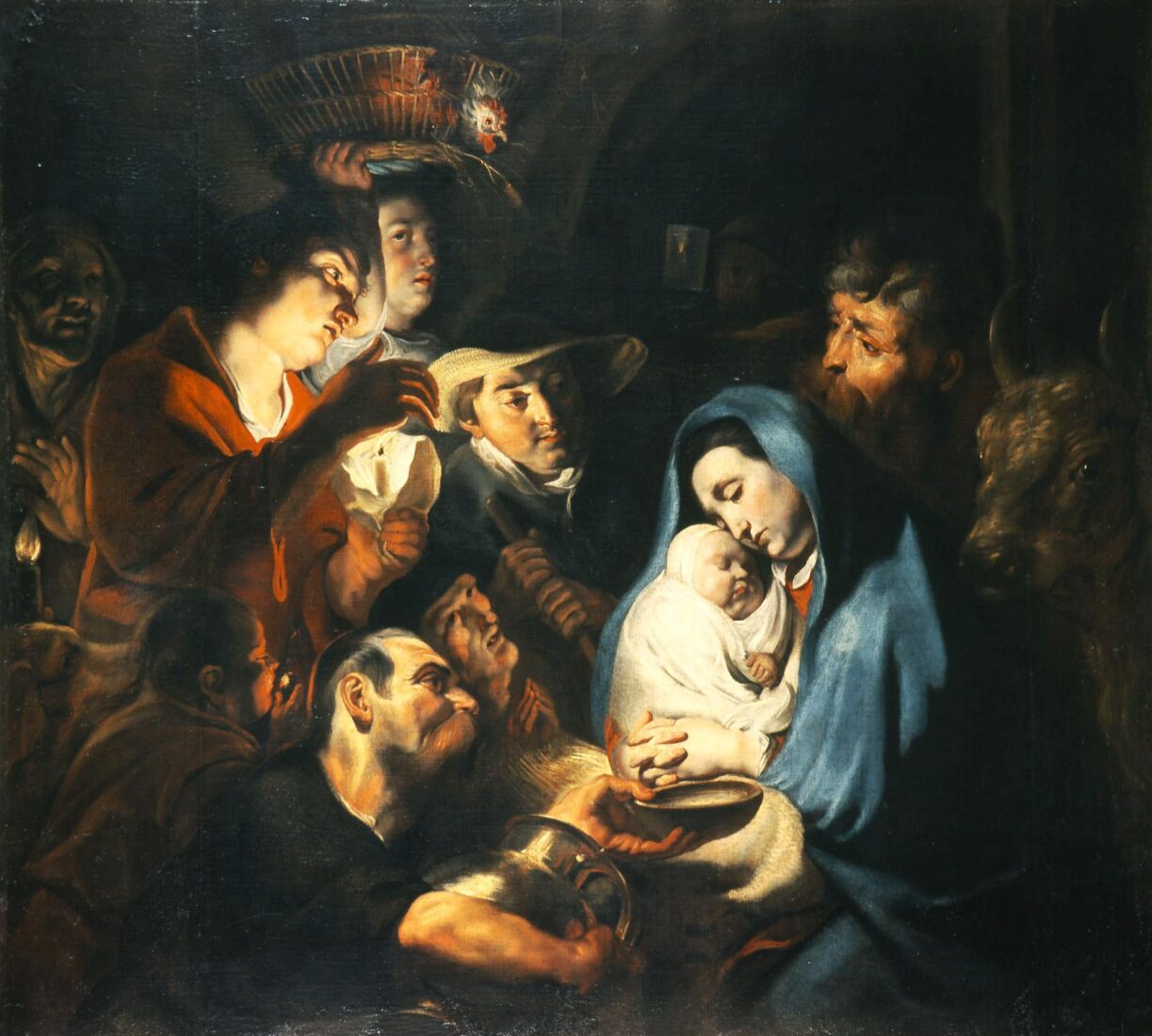
After the 16th century the Adoration of the Shepherds became one of the painters’ favorite themes in the Low Countries, while during the 17th, and particularly in Rubens’s work, it was enriched with the presence of female figures. According to the Evangelist Luke (2, 15-21) “Hastering there, the shephers found Mary, Joseph and Infant, lying in his crib”. In his work Jordaens depicts the moment when the shepherds, the young shepherds and shepherdesses are adoring the Holy Infant. The infant, however, is not in his crib but rather asleep in his mother’s arms. The composition is focused on the human relationship between mother and child. Wrapped in a blue cloak, the Virgin Mary is tenderly holding her baby, who, serene and secure, sleeps on her shoulder. Her head turned to the side, in the pose known as “Our Lady Sweetly-Kissing”, it rests on his forehead. The two of them appear to be cut off from all that is going on around them. Joseph is standing behind her while the donkey next to him indicates the participation of the animals in the scene. To their left a group of shepherds, young shepherds and shepherdesses are gazing devoutly at the Divine Infant. Indeed, one shepherd on the primary plane is offering him a bowl of milk while a woman to the rear is bringing a rooster in a farm basket. The scene takes place at night and is lit by a candle held by a young shepherd on the left. Its light spreads over the faces of the two central figures creating a delicate chiaroscuro effect which infuses the main theme with a sense of tranquility. Conversely, there are strong contrasts of light and shadow on the shepherd’s faces, thus increasing the feel of mystery this moment is imbued with.
The similarities between this work and the one at the Metropolitan Museum of Art in New York (“The Holy Family with Shepherds”) from 1616, lead us to the conclusion that this must have been done around 1615-1616. The composition, furthermore, follows the example set by Italian art, which was well-known in Antwerp, especially after Rubens returned from Italy, and this was the style Jordaens painted in, at least in the early stages of his career.
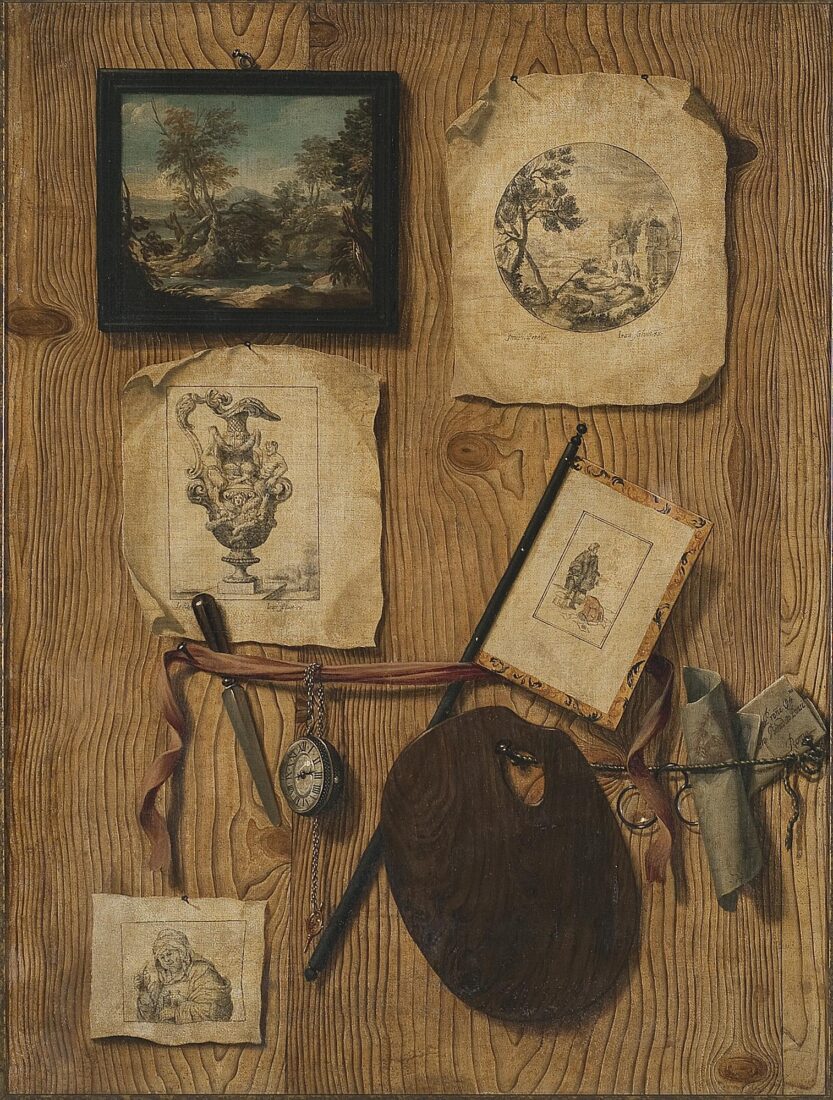
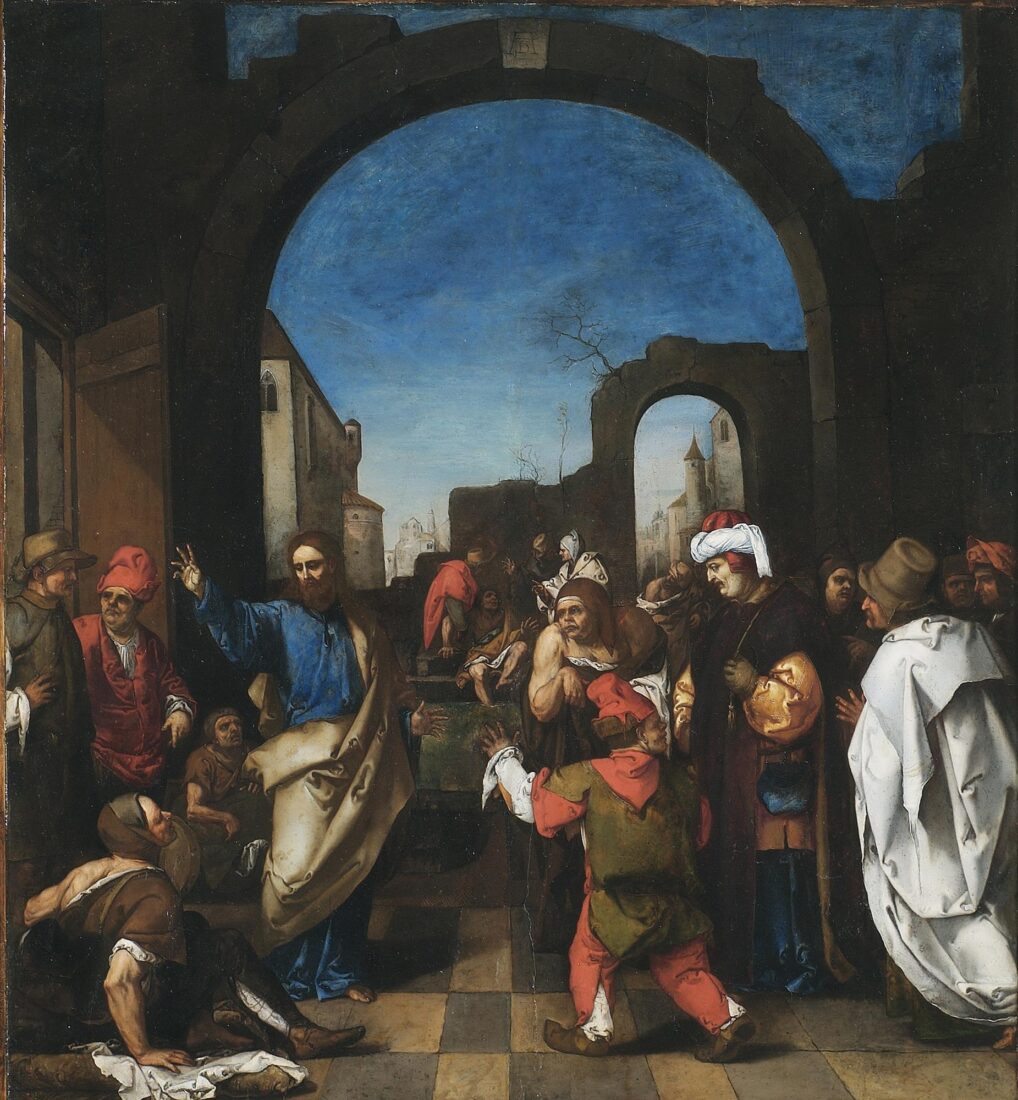
In Bernardo de’ Dominici’s impressive and laudatory biography of Luca Giordano (which is included in Gian Pietro Bellori’s “Le vite de’ pittori, scultori et architetti moderni” and is considered a major historical source for Neapolitan Baroque painting), the author emphasizes the painter’s “enormous virtuosity” for copying the techniques of the great artists of the past. He writes that the Abbot of the Certosa Monastery of San Martino in Naples “insisted that Luca was capable of imitating every technique except for that of Albrecht Durer, whom he admired passionately and whose work he had purchased for the sum of 600 ducats. This painting depicted in great detail the story of the Adoration of the Magi. The experts had assured the Abbot that this was an authentic Durer. The Abbot, who boasted of the purchase in front of Luca, heard the latter say that he had painted this picture himself and to verify his claims showed him the place on the back of the panel where he had discreetly signed it. Feeling that he’d been defrauded, the Abbot sought justice, demanding reimbursement for the sum he’d paid for the work believing that it was a Durer, not a Giordano. The case reached the courts of the Royal Council, but Luca was acquitted because the judges recognized that his worth was as great as Durer’s. However, to placate the Abbot, Prince Sonnino purchased the work, which he liked at any rate, for the sum of 1600 ducats. To this day, the painting is shown to art lovers as a Durer, with the truth subsequently revealed truth as incontrovertible proof of Luca Giordano’s enormous talent. (“Vita del cavaliere D. Luca Giordano pittore napoletano”, Naples, 1729, p. 92).
Despite the debate over the painting’s subject and the location of the signature, art historian Wilhelm R. Valentiner, as well as most subsequent Giordano scholars, believes that this incident is related to the painting in the Bohler and Steinmeyer Collection in New York, which depicts the “Healing of the Paralytic”. As Valentiner describes it, the top part of the gate that frames the scene bears Durer’s familiar monogram, whereas the shadow on the left, written sideways so as to be concealed by the frame, contains Giordano’s signature (“An Early Forger,” Art in America, I, 1913, pp. 195-208). This painting then passed into the possession of an unknown owner to reappear at auction in Munich in 1933. Since then its whereabouts are unknown.
In 1967, the National Gallery purchased a painting by an unknown painter, entitled “The Pool of Siloam”. In 1968-69, Robert Lebel, who had been asked to appraise the Western European painting collection, attributed it to Francesco Villamena (1564-1624). But on a visit to the National Gallery in 1988, Professor Federico Zeri attributed it to an early work of Luca Giordano. Angela Tamvaki, the then curator of the National Gallery’s Western European painting collection, did additional research and began to suspect that it was the painting that Wilhelm R. Valentine referred to and published in 1913. This opinion was supported by Giuseppe de Vito, a Luca Giordano scholar and specialist of his early works, who instigated a laboratory investigation into the existence of a signature and date.
The scholars’ suspicions were confirmed and proven correct when, in 1997, an examination of the painting using infrared reflectography revealed the signature and date written on along the side concealed by the frame on the lower left margin of the painting. No trace, however, was found of the Durer initials added by Giordano. In July 2008, a cleaning by the National Gallery conservators uncovered the monogram on the upper portion, in the center of the arch, a fact that identifies this painting as the one mentioned by Valentiner.
The painting depicts the scene described in the Gospel according to John, of the healing of the paralytic at the pool at Bethzatha. According to John, from time to time an angel would agitate the waters of the pool at Bethzatha and the first person able to enter it would be cured of every affliction. The ill and lame would gather around the pool ready to jump in. But the paralytics were unable to pass ahead of the others and thus remained waiting their entire lives. Jesus performed the miracle of healing a paralytic in order for him to then enter the pool and complete his cure.
Christ on the left side of the painting with a gesture of blessing heals the paralyzed man who looks him in the eye as he struggles to stand up. The crowd around them, made up of the ill, relatives and passersby, observe the scene with curiosity. In the background, two men are supporting a patient emerging from the miraculous water. The void in the center foreground of the composition leads the viewer’s eye to the pool, the symbol of baptism through which Salvation is completed. The dominant reddish-brown palette creates a sense of hopelessness, whereas the blue of Christ’s mantle and the sky symbolize hope.
The 1997 examination of the painting with infrared reflectography revealed yet another surprise. There had been angel on the pool in the center background of the painting, who was agitating the water with his wand. It is not known why Giordano painted over the angel – perhaps to give more emphasis to Christ’s miracle – its form however remains on the work like an invisible presence.
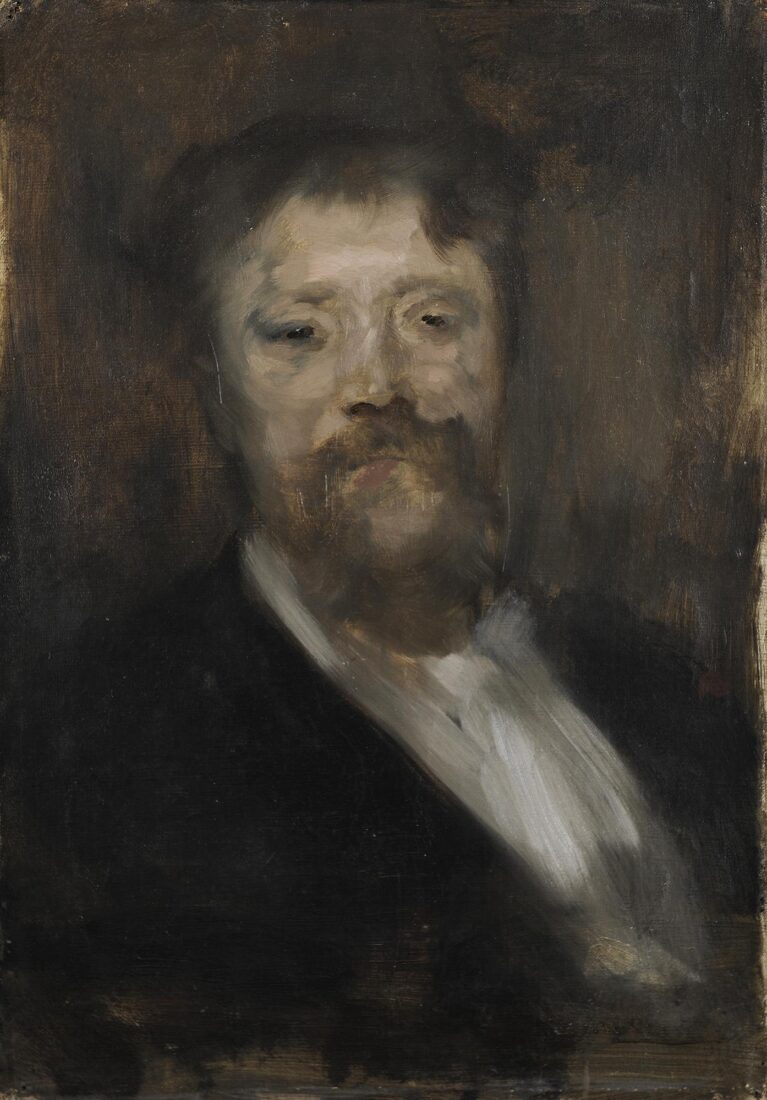
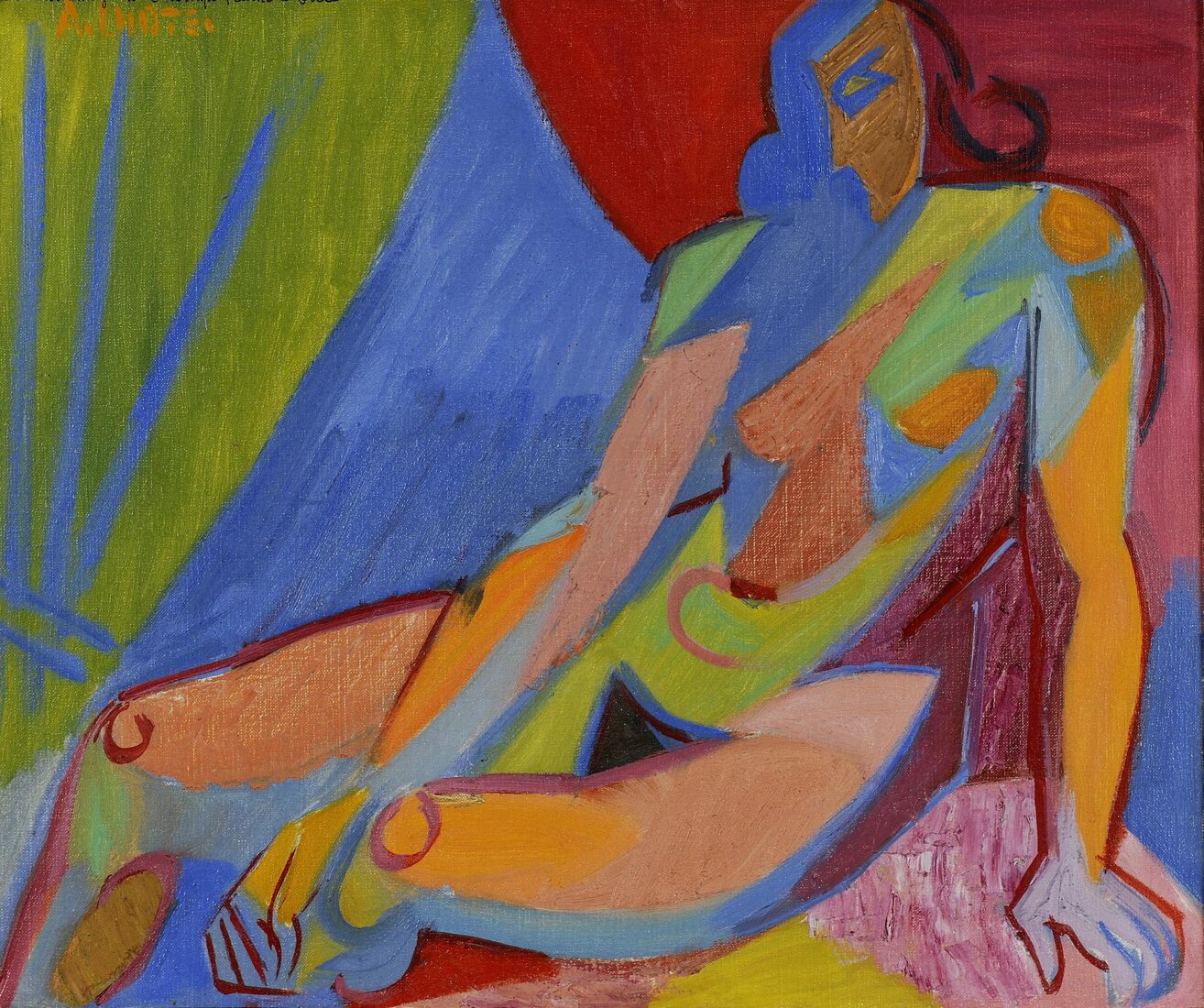
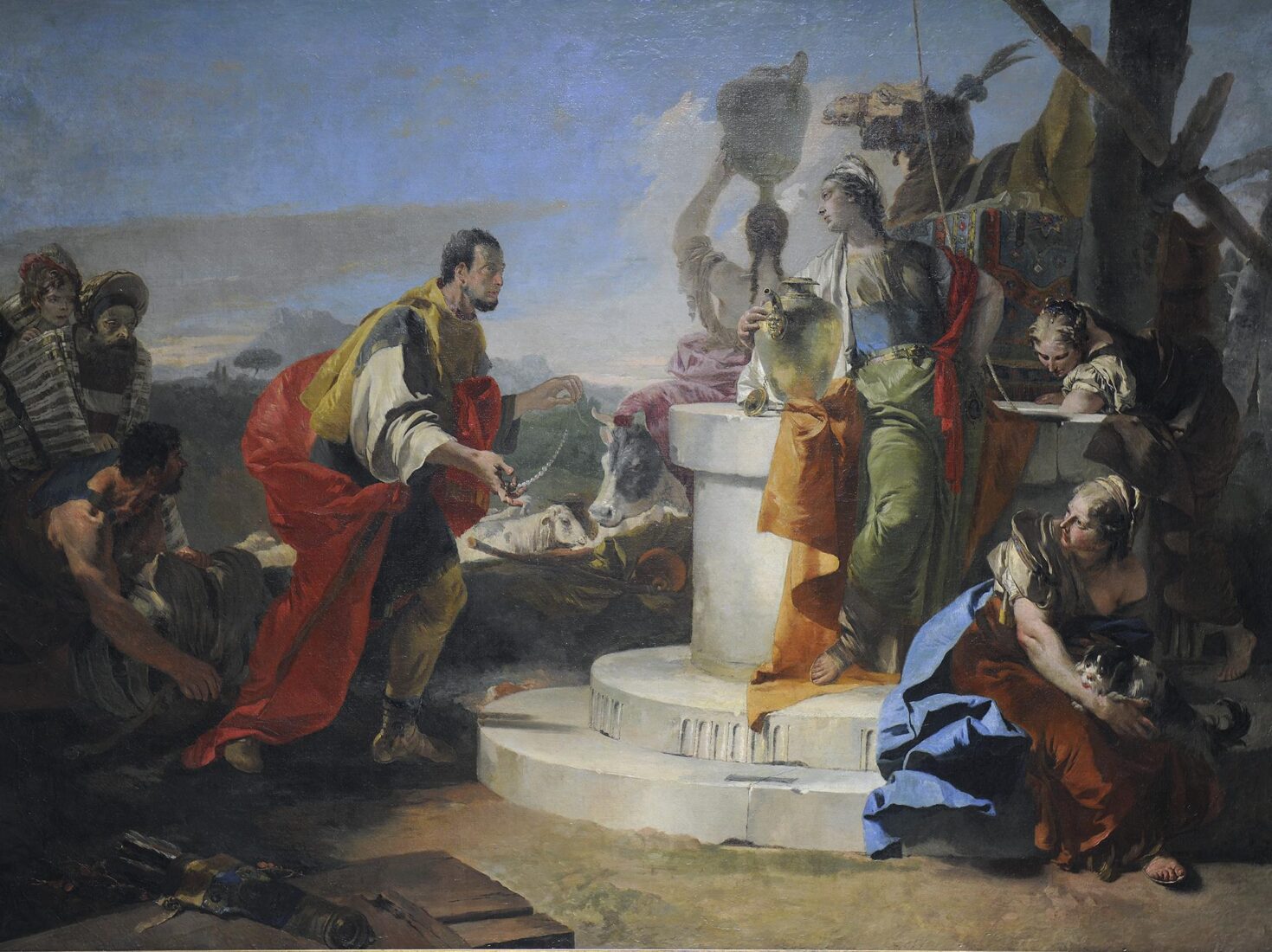
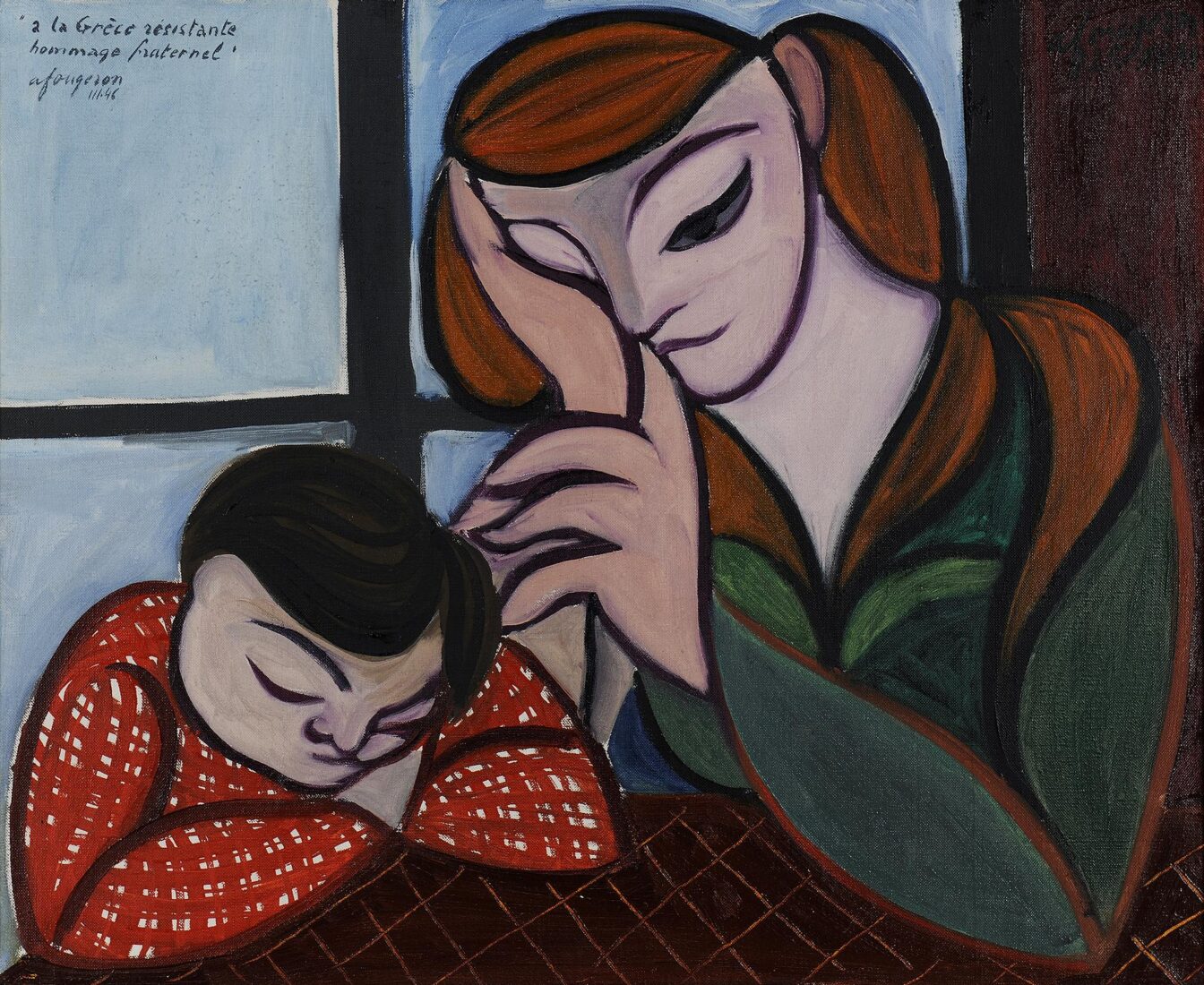
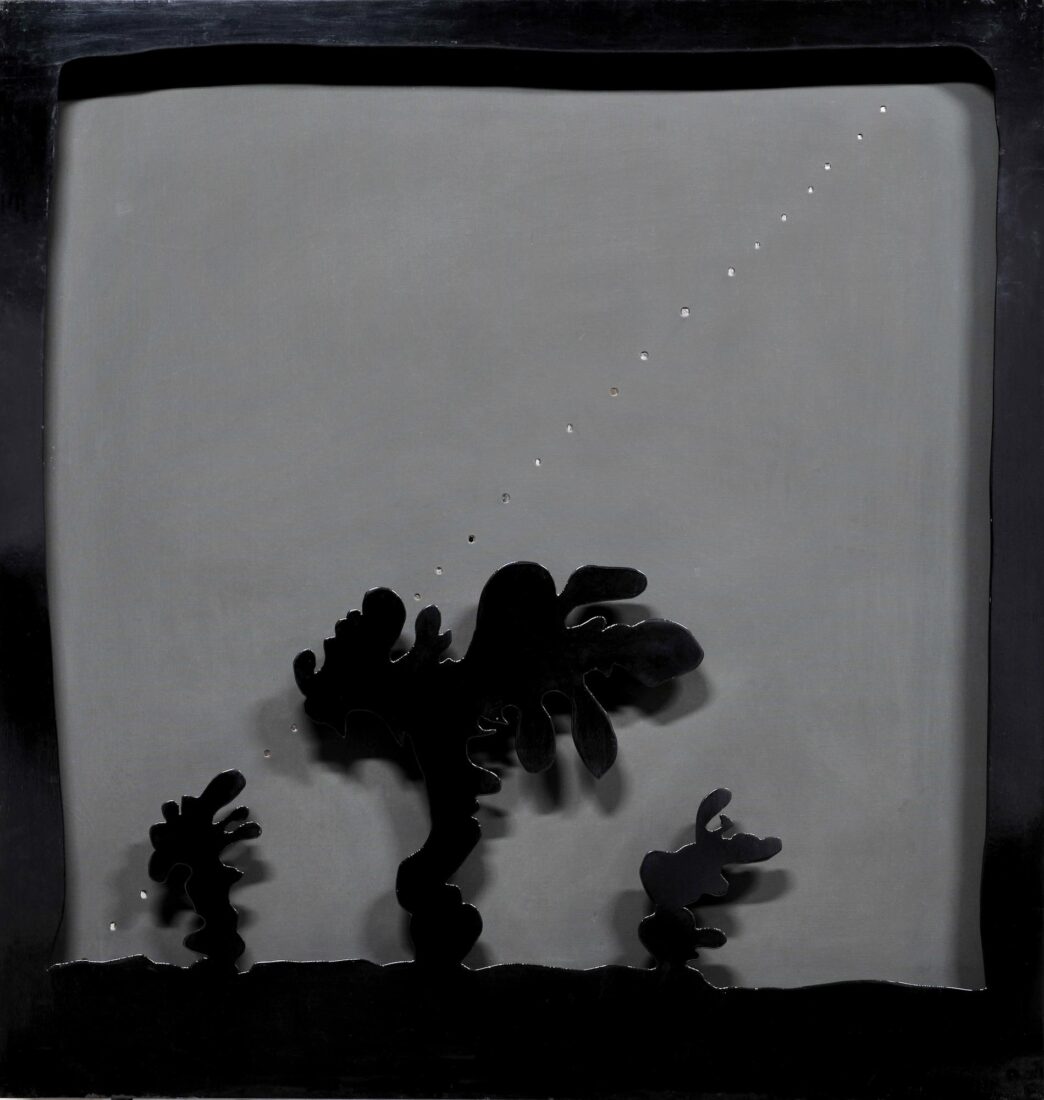
Fontana was born in Argentina to an Italian father. He spent large periods of his life in Argentina and in Italy. He founded Spatialism in 1947 in Milan, an art movement combining elements from science and technology. Since 1949, he titled almost all his works Spatial Concept [Concetto Spaziale], seeking to capture the immaterial outer space. Lunar Landscape, from the series Small Theatres [Teatrini], made in 1964-1966, is an imaginary “spacewalk”, evoked by the holes – traces in the “sky” in the background, amongst the figures of unknown beings.
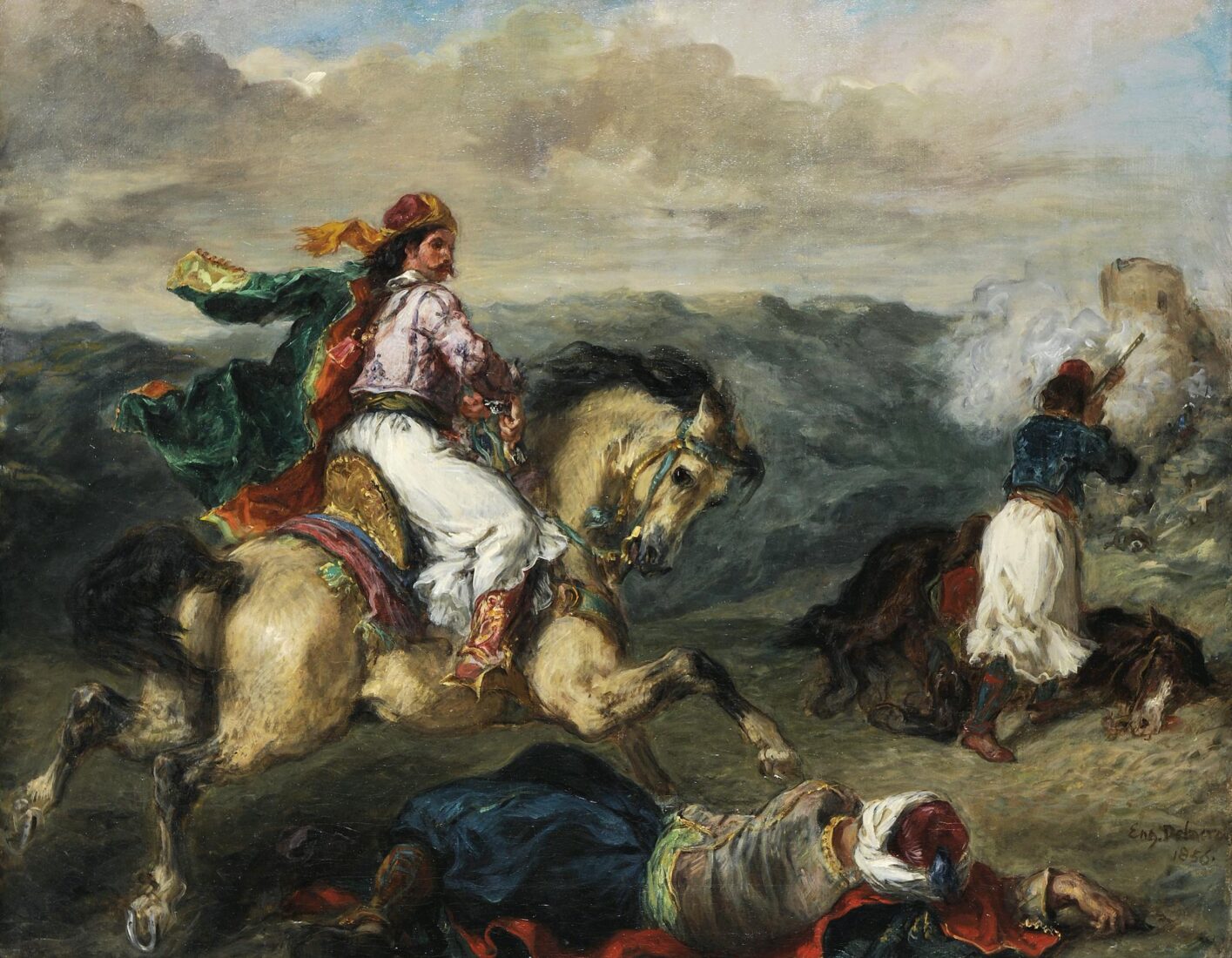
Approximately thirty years after the founding of the modern Greek state, the subjects connected to the Greek War of Independence continued to inflame the imagination of certain artists who belonged to the so-called Romantic generation and who had been captivated by the spirit of philhellenism. Though this could be viewed as an eccentricity, and a marked preference for whatever smacked of the oriental, the painting by Delacroix – which impartially bears the neutral title, “Episode from the Greek War of Independence”, independent of any anecdotal element it may contain – not only could but must be confronted, conversely, as a painterly revival of a subject the artist had already been involved with during his youth, in 1826-1827, a painting known under the title “Scene from the Contemporary War Between the Turks and Greeks”, a title as neutral as the previous one (Winterthuur, Oscar Reinhart Collection). The presentation of this work at the Paris Salon, in October 1827, was received by the official criticism of the time in a somewhat less than complimentary fashion. The work was characterized, for example, as “bad both in terms of form and color”, despite the fact there was “a certain amount of movement in it, when viewed as a whole”.
The painting at the National Gallery is not merely a new version of the lost work of the painter’s youth, and one which had the exact same dimensions, but a version produced by an artist who had himself matured, enriched by means of his lucid vision in terms of color, design, light and, first and foremost, the composition’s expressivity. “Contemporary subjects [are] difficult for one to handle because of the absence of the nude and the austerity of the garments”, he wrote on 13 January 1856 (Dairy, vol. III, 24). There can be no doubt that one of the basic elements of the painting, that is, the attire of the mounted warrior depicted in full detail – the white foustanella, the variety of leggings, the black sash-belt, the embroidered waistcoat and the superb green cape, which is lined with red silk, and flutters in the air with the same movement as that of the fez and the headscarf – as well as the Greek horseman himself, depicted from the side, guide both the eyes and the reading by means of the colors and the design.
The horse – just as Rubens would have rendered it – is also a participant, if in a somewhat supplementary manner; its galloping does not of necessity lead to a direct confrontation between “good” and “bad”, between Christian and infidel. Delacroix avoided any kind of allusion to war which could be interpreted historically and created a painting which is expressed more through color and motion than through any specific subject matter. The painter of the “Massacre at Chios” here again made use of an antiheroic, antiepic style, in which the only real warrior shown with his rifle, his dead horse and the dead Ottoman – symbol of defeated Islam, over whom the horse jumps – all function merely as supplementary characteristics. It is obvious that the absence of dramatic elements – such as those found in scenes of single combat, in a work from 1926 (“The Giaour and Hasan”, Chicago, Institute of Art) and 1836 (“The Battle of the Giaour and the Pasha”) or 1856 (“The Giaour and the Pasha”, Cambridge, Massachusetts, The Fogg Art Museum) where the brushstroke itself gets carried away and reaches the boundary of true violence – only serves to underline in this specific work the subject of the struggle for freedom: the mounted Greek warrior can be interpreted as the embodiment, par excellence, of the ideal, an idea which has been cleansed of any superfluous element connected to a historically and actually recognizable timeliness.
